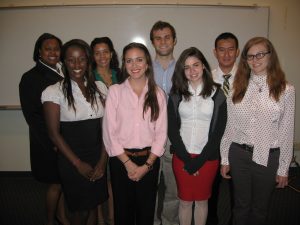C-MEDS Interns Focus on Dispersant Research and Community Outreach
– September 17, 2012
Ten undergraduate students from Louisiana spent their summer conducting research with expert scientists who are actively pursuing advanced understanding of dispersants for improved oil-spill response. These interns also helped local elementary school students with hands-on experiments to spark interest in pursuing science that matters to their communities.
The students had a valuable experience in learning the science behind the design of dispersants, visualizing oil breakup by dispersants through advanced imaging, and in understanding the translation from laboratory scale experiments to application in ocean environments. – Dr. Vijay John
With support from a Gulf of Mexico Research Initiative (GOMRI) award, the Consortium for the Molecular Engineering of Dispersant Systems (C-MEDS) hosted a ten-week Summer Research Academy program. Dr. Vijay John, Director of C-MEDS, and his outreach team worked with the Tulane Center for Engaged Learning and Teaching and the National Science Foundation’s Research Experience for Undergraduates Program at Louisiana State University to select interns and pair them with established scientists in their field of study. A high school educator participated in their research to learn additional teaching methods.
The ten-week program culminated with two events: a Science Demonstration Day with elementary school students and the Summer Research Academy Symposium with presentation on research results and learning.
K-7 students from St. James Methodist Church Summer Camp in New Orleans, LA participated in the Science Demonstration Day. The goal of this outreach activity was to introduce young students to the field of science and show that it plays a part in everyday life. The C-MEDS interns discussed the importance of research and then led students in hands-on science experiments about chemical reactions using “Baking Soda and Vinegar Volcano” and “Oil and Water Don’t Mix” demonstrations.
As one of the program coordinators, I saw first-hand the hard work and enthusiasm of the undergraduates while preparing for and engaging the elementary school students. As a parent of two campers, I witnessed the excitement of the campers who loved the “hands-on” lab experience and the unique opportunity to learn from young scientists. – Bennetta Horne
The core of the interns’ work was their dispersant-related research. At the August symposium, these undergraduate students presented their work:
|
Meet the 2012 C-MEDS Summer Interns Nicholas Altieri, Tulane Brian Broom-Peltz, Tulane Sinead Holleran, Tulane Julie Kaiga, Tulane Ta’Rayan Lloyd, Louisiana State University Elise Mills, Tulane Aurielle Modster, Tulane Tyler Nesmith, Louisiana State University Steven Nguyen, Louisiana State University Chemical Engineering Melanie Sebastian, Tulane Rebecca Tamayo, Tulane |
Modster and Sebastian: Replicating Surface Chemistry and Topography of Marshland Grasses via Polymer Molding Techniques
Broom-Peltz: Synthesis and Characterization of Ultra-Thin Shell Hollow Silica Microspheres for Pickering Emulsions of Oil in Water
Mills: Oil and Bacteria Transport in Porous Media via Packed-Bed Capillary Microscopy
Kaiga and Tamayo: Microbes Eat Gulf Oil Spill – Electron Micrographs of Indigenous Oil-Degrading Bacteria at the Oil-Water Interface
Altieri: Investigations into Molecular Volumes of Sodium Decyl Sulfate (SDeS)
Holleran: Primitive Hydrophobic Interactions from Analysis of Spontaneous Formation of Atomic-Scale Cavities in Liquid Water
Nguyen: Soluble Chemical Dissolution-Produced Sinker Oil (Solute-Sinking) from Seep-Sea Spill with and without Dispersant
Lloyd: Volatile Chemical Evaporation-Produced Sinker Oil (EVAPO-SINKING) from Sea-Surface Slick with and without Dispersant
Nesmith: Mass Transfer Characteristics of Organic Drops in Water
The C-MEDS Summer Research Symposium was held in conjunction with the annual NSF-sponsored Undergraduate Research Mentoring Program, Enhancing Diversity in Environmental Biology (EDEB). At the symposium, five students in the EDEB program presented their research on breast cancer (Diari Gilliam and Karry Wright); reconstructing seed bank profiles (Jeremiah Jackson); marine diversity and water quality in the Tana River System, Kenya (Maya Patterson); and temperature impacts on northern cricket frogs (Tammy Vo).
The C-MEDS project includes twenty-two research institutions in seventeen states. Together, scientists from these institutions lead a focused effort to understand the role of dispersants and related chemical compounds in mitigating the effects of deep-sea hydrocarbon releases and in designing the next generation of dispersants. Their overall research objective is to address the question, “What needs to be done if a Deepwater Horizon type spill happens again?”
This research is made possible by a grant from The Gulf of Mexico Research Initiative (GoMRI). The GoMRI is a 10-year, $500 million independent research program established by an agreement between BP and the Gulf of Mexico Alliance (GOMA) to study the effects of the Deepwater Horizon incident and the potential associated impact of this and similar incidents on the environment and public health.
© Copyright 2010- 2017 Gulf of Mexico Research Initiative (GoMRI) – All Rights Reserved. Redistribution is encouraged with acknowledgement to the Gulf of Mexico Research Initiative (GoMRI). Please credit images and/or videos as done in each article. Questions? Contact web-content editor Nilde “Maggie” Dannreuther, Northern Gulf Institute, Mississippi State University (maggied@ngi.msstate.edu).






